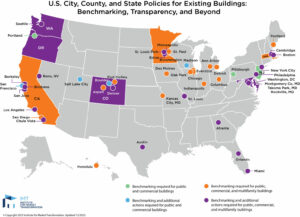What is Benchmarking?
Benchmarking is a process of comparing the energy performance of buildings, facilities, or processes against industry standards. It involves measuring and analyzing energy usage data to assess the efficiency of energy consumption and identify opportunities for improvement.
Why is Benchmarking Becoming More Popular?
Energy benchmarking is becoming increasingly important in the United States because it provides a way to measure and monitor progress on reducing greenhouse gas emissions of our buildings. Benchmarking policies and laws are proliferating across the US. Below are a few key points highlighting the features of these growing requirements.
- Expansion of the Types of Properties That Benchmarking Policies Apply To: Benchmarking policies are expanding to cover a wider range of buildings in the public and private sectors. Recently adopted policies require benchmarking for buildings as small as 10,000 square feet and now include more categories of multifamily properties compared to the earliest adopted benchmarking policies.
- Standardization of Implementation: Most cities, counties, and states that require energy benchmarking and reporting mandate the use of ENERGY STAR® Portfolio Manager for benchmarking reporting. Portfolio Manager is a free online tool that standardizes the benchmarking process and enables easy exchange of benchmarking data with local authorities.
- Improved Access to Energy Data: Electric and natural gas utilities are increasingly providing improved access to energy use data in formats that allow easy automation of energy use data entries in Portfolio Manager. The tools also allow for the reporting of aggregate meter data for properties with multiple meters such as multifamily properties with separate meters for individual residences. This enables a wider range of properties to be benchmarked quickly and with a high degree of accuracy.
- Benefits of Benchmarking: Benchmarking allows building owners and occupants to understand their building’s relative energy performance and identify opportunities to cut energy waste. In addition, according to the US Environmental Protection Agency (EPA), historically, buildings that benchmarked energy use in Portfolio Manager achieved average annual energy savings of 2.4%.
- Jurisdiction-specific Requirements: Cities, counties, and states have varying requirements for energy benchmarking. Differences range from the types and sizes of buildings that must report energy benchmarking data to when data must be reported. So, it is important to know what the local requirements are for your properties.
Benchmarking Regulations in the US
Although benchmarking is gaining popularity now, its origins can be traced back to 2008. , Washington, DC became the first city in the US to enact mandatory energy benchmarking and disclosure requirements for its buildings. The initial law required privately owned multifamily or commercial buildings over 50,000 gross square feet to benchmark energy and water use.
Ever since DC initiated benchmarking regulation, several other states, cities, and counties in the US have adopted mandatory building energy benchmarking policies for existing buildings. As shown in Figure 1, the Institute for Market Transformations (IMT) currently lists 53 jurisdictions with benchmarking requirements. New regulations are being added on a regular basis and are expected to become ubiquitous in the next several years.

A few notable jurisdictions include:
- New York City, New York: The Local Law 84 (LL84) in New York City requires owners of buildings larger than 25,000 square feet to annually benchmark their energy and water usage by May 1st.
- Washington, DC: The District of Columbia requires annual benchmarking data to be submitted by July 1, 2024. In addition, the Clean Energy DC Omnibus Amendment Act (CEDC Act) of 2018 expanded benchmarking to include privately-owned buildings larger than 25,000 square feet and District-owned buildings larger than 10,000 square feet as of 2021. It will expand to include privately owned buildings larger than 10,000 square feet starting in 2024. Finally, the CEDC Act requires third-party verification of benchmarking data as of 2023.
- Montgomery County, Maryland: Montgomery County, Maryland requires the tracking of energy use of buildings 25,000 gross square feet and greater in the county in ENERGY STAR Portfolio Manager. Benchmarking data must be verified by a Recognized Data Verifier, and benchmarking data must be reported to the County annually for public disclosure by June 1st.
- Chicago, Illinois: Chicago’s Energy Benchmarking Ordinance requires commercial, residential, and municipal buildings larger than 50,000 square feet to report their energy usage annually by June 1st.
- Detroit, Michigan: Detroit City Council adopted a benchmarking policy that requires all municipal buildings, as well as commercial and multifamily buildings over 100,000 square feet to annually report their energy and water usage, beginning in 2024. Data for the 2023 calendar year is due by October 1st, 2024. Subsequent annual data is due by June 1st of the following year.
- Boston, Massachusetts: Boston’s Building Energy Reporting and Disclosure Ordinance (BERDO) requires large- and medium-sized buildings to report their energy usage annually by December 31st.
- South Portland, Maine: Passed an Energy and Water Use Performance Benchmarking ordinance, which applies to municipal and commercial buildings greater than 5,000 square feet by May 1st.
How to Benchmark Correctly?
If you read our blog, Shoot for the “Stars”, you now know how to set up a profile in ENERGY STAR Portfolio Manager. While it seems very straightforward initially, getting benchmarking right can be challenging. Making mistakes during the benchmarking process can compromise the accuracy of the results, which may lead to incorrect conclusions and ineffective energy management strategies. Following are the steps to be taken to accurately benchmark your data in ENERGY STAR Portfolio Manager:
![]()
- Data Collection:
- Gather utility bills and basic building information like gross floor area (GFA), parking area, etc. to input into Portfolio Manager.
- Entering Data:
- Ensure data accuracy by entering billing periods and energy use data as they are shown on your billing documents. Pay careful attention to units and be sure the units in Energy Star match the units on your billing documents.
- Follow EPA guidelines on how to accurately enter property details for specific building use types.
- Updating Property Data:
- On an annual basis or more frequently, review the energy meters set up for the building and add/update bills or edit past entries as needed.
- Update the building use details and meter information as and when they change. For example, if your building had a major renovation in January 2023, and the GFA increased, make sure to update the GFA to the new number in Portfolio Manager.
- Verification:
- Get your data verified by a qualified professional to ensure accuracy and completeness.
By following these steps, you can accurately benchmark your data in ENERGY STAR Portfolio Manager, analyze performance, identify areas for improvement, track progress over time, and potentially earn recognition for superior energy efficiency achievements. If you read our Common Mistakes Made in Benchmarking: Avoiding the Pitfalls blog, you are familiar with common oversights made during benchmarking and how to rectify them.
What is Benchmarking Verification and Where is it Required?

Benchmarking verification by a qualified professional involves having a third party with approved credentials review all benchmarking data to ensure accuracy and compliance with standards. In the US, certain cities and states have requirements for data verification in benchmarking:
- Washington, DC: Buildings in Washington, DC are required to report benchmarking data by July 1, 2024, with the data needing third-party verification.
- Montgomery County, MD: Montgomery County’s benchmarking law mandates that buildings must have their Portfolio Manager data verified by a Recognized Data Verifier during the first year of reporting and every three years thereafter.
By complying with these verification requirements and engaging Recognized Data Verifiers with approved credentials, building owners can ensure the accuracy and compliance of their benchmarking data in accordance with local regulations.
As a building owner/manager, you can rest assured that you don’t have to handle everything on your own. Baumann Consulting has significant experience with benchmarking and data verification. We can assist you in setting up your Portfolio Manager profile, advise you on ways to benchmark your property more accurately and provide third-party benchmarking data verification for your property.







